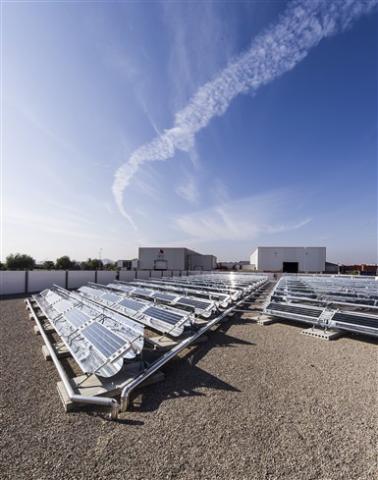
Geneva, 9 March 2012. At Geneva International Airport today SRB Energy delivered the first of the solar panels that will form one of the largest solar energy systems in Switzerland. Ultimately, some 300 high-temperature solar thermal panels will cover a surface of 1200 square metres on the roof of the airport’s main terminal building. The panels, which will be used to keep the buildings warm during the winter and cool in the summer, are derived from vacuum technology developed at CERN for particle accelerators.
“We are delighted that Geneva International Airport has opted for this technology,” says Cristoforo Benvenuti, the inventor of the panels, who has been working on vacuum technology at CERN since the 1970s. “The panels emerged from vacuum technologies that were developed for fundamental physics purposes, and it is highly gratifying to see them put to use for renewable energy.”
"This new generation of solar panels is an innovative green technology that is the fruit of a partnership between CERN and industry", explains Enrico Chesta, head of the Technology Transfer Section of CERN's Knowledge Transfer Group. “Like medicine and information technology, energy is becoming a domain in which accelerator and detector technology is finding successful applications.”
Particle beams can circulate only in pipes from which the air has been removed, otherwise they would quickly be stopped. Vacuum technologies were therefore developed to meet the needs of the accelerators. For colliders, where accelerated particles are made to collide with each other, a high-grade vacuum is even more important. This is because they have beams of particles running for hours at a time, with a few particles actually colliding at any given crossing point. The world's first proton-proton collider, the Intersecting Storage Rings (ISR), began operation at CERN in 1971, marking the start of ultra-high vacuum research at the Laboratory. At the end of the 1980s, CERN’s Large Electron–Positron collider (LEP) was setting new vacuum records, thanks to the use of 20 kilometres of getter strips, a material which attracts residual gas molecules like bugs to flypaper. But it was the marriage of thin-film coating techniques with getter technology for the LHC in the 1990s that paved the way for solar panel applications.
The ultra-high vacuum provides the panels' heat chambers with exceptional insulation, vastly reducing heat loss and greatly improving efficiency. "We've had temperatures of 80°C inside the panel when the panels were covered in snow", says Benvenuti.The panels also recover the energy produced by diffuse light more efficiently than traditional panels. The two technologies make them particularly suited to colder, less sunny climates where classic solar panels are less efficient.
Cristoforo Benvenuti proposed getter vacuum technology for LEP, and patented the technology of thin-film getter coating for CERN. CERN has made licences available to commercial companies in its Member States. In 2005, the Spanish automotive company Grupo Segura teamed up with Benvenuti to form SRB Energy. The company obtained a licence to exploit the technology, and production facilities were built near Valencia. Its R&D activities are still based at CERN in Meyrin (Switzerland).
"The spin-off company SRB Energy is an example of how technologies developed for fundamental research can promote innovation in the Member States", says Giovanni Anelli, head of CERN's Knowledge Transfer Group. "CERN has recently strengthened its knowledge transfer policy with a view to optimising the positive impact of high-energy physics on everyday life".
Further information:
Knowledge transfer at CERN:
- Marina Giampietro, communications officer, +41 22 767 9381
- SRB Energy: Cédric Petitjean, +41 22 767 1774
Video:
- CERN News
- Interview with Cristoforo Benvenuti
- Interview with Francisco Segura and shots of solar panels at CERN
- SRB-Geneva airport movie
Photos:
CERN, the European Organization for Nuclear Research, is the world's leading laboratory for particle physics. It has its headquarters in Geneva. At present, its Member States are Austria, Belgium, Bulgaria, the Czech Republic, Denmark, Finland, France, Germany, Greece, Hungary, Italy, the Netherlands, Norway, Poland, Portugal, Slovakia, Spain, Sweden, Switzerland and the United Kingdom. Romania is a candidate for accession. Israel is an Associate Member in the pre-stage to Membership. India, Japan, the Russian Federation, the United States of America, Turkey, the European Commission and UNESCO have Observer status.